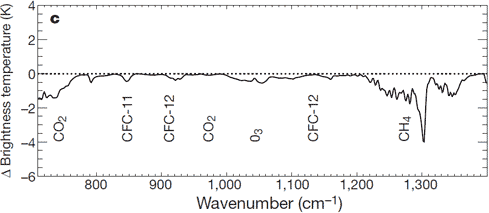Is the CO2 effect saturated?
What the science says...
| Select a level... |
 Basic
Basic
|
 Intermediate
Intermediate
|
 Advanced
Advanced
| ||||
|
If the CO2 effect was saturated, adding more CO2 should add no additional greenhouse effect. However, satellite and surface measurements observe an enhanced greenhouse effect at the wavelengths that CO2 absorb energy. This is empirical proof that the CO2 effect is not saturated. |
|||||||
CO2 effect is saturated
"Each unit of CO2 you put into the atmosphere has less and less of a warming impact. Once the atmosphere reaches a saturation point, additional input of CO2 will not really have any major impact. It's like putting insulation in your attic. They give a recommended amount and after that you can stack the insulation up to the roof and it's going to have no impact." (Marc Morano, as quoted by Steve Eliot)
If the CO2 effect is saturated, adding more CO2 should add no additional greenhouse effect. However, observations continue to find an enhanced greenhouse effect as CO2 levels rise. The paper Increases in greenhouse forcing inferred from the outgoing longwave radiation spectra of the Earth in 1970 and 1997 (Harries 2001) attempts to find out. In 1970, NASA launched the IRIS satellite that measured infrared spectra between 400 cm-1 to 1600 cm-1. In 1996, the Japanese Space Agency launched the IMG satellite which recorded similar observations. Harries 2001 compared both sets of data to discern any changes in outgoing radiation over the 26 year period. The resultant change in outgoing radiation was as follows:

Figure 1: Change in spectrum from 1970 to 1996 due to trace gases. 'Brightness temperature' indicates equivalent blackbody temperature (Harries 2001).
What they found was a drop in outgoing radiation at the wavelength bands that greenhouse gases such as CO2 and methane (CH4) absorb energy. The change in outgoing radiation over CO2 bands was consistent with theoretical expectations. Thus the paper found "direct experimental evidence for a significant increase in the Earth's greenhouse effect".
This result has been confirmed by subsequent papers using the latest satellite data. Griggs 2004 compares the 1970 and 1997 spectra with additional satellite data from the NASA AIRS satellite launched in 2003. Chen 2007 extends this analysis to 2006 using data from the AURA satellite launched in 2004. Both papers found the observed differences in CO2 bands matched the expected changes based on rising CO2 levels. Thus we have empirical evidence that increased CO2 is preventing longwave radiation from escaping out to space.
Measurements of downward longwave radiation
What happens to longwave radiation that gets absorbed by greenhouse gases? The energy heats the atmosphere which in turn re-radiates longwave radiation. This re-radiated energy goes in all directions. Some of it makes its way back to the surface of the earth. Hence we expect to find increasing downward longwave radiation as CO2 levels increase.
Philipona 2004 finds that this is indeed the case - that downward longwave radiation is increasing due to an enhanced greenhouse effect. Evans 2006 takes this analysis further. By analysing high resolution spectral data, the increase in downward radiation can be quantitatively attributed to each of several anthropogenic gases. The results lead the authors to conclude that "this experimental data should effectively end the argument by skeptics that no experimental evidence exists for the connection between greenhouse gas increases in the atmosphere and global warming."
So we have multiple lines of empirical evidence for an enhanced CO2 greenhouse effect. Satellite measurements confirm that less longwave radiation is escaping to space. Surface measurements detect increased longwave radiation returning to Earth at wavelengths matching increased CO2 warming. And of course the result of this energy imbalance is the accumulation of heat over the last 40 years.
Intermediate rebuttal written by dana1981
Update July 2015:
Here is a related lecture-video from Denial101x - Making Sense of Climate Science Denial
Last updated on 26 October 2016 by pattimer. View Archives































 Arguments
Arguments





































Climate Myth...